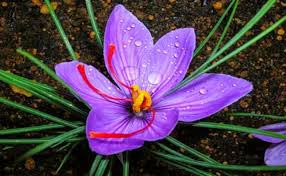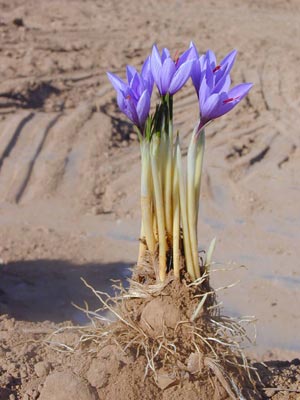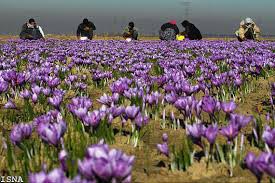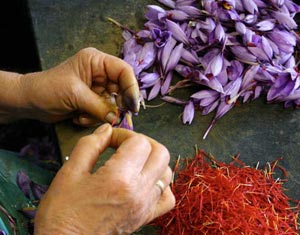Saffron is one of the highly prized spices known since antiquity for its color, flavor and medicinal properties. It is the dried “stigma” or threads of the flower of the Crocus sativus plant. It is a bulbous perennial plant that belongs to the family of Iridaceae, in the genus, Crocus, and known botanically as Crocus sativus.
This exotic spice is a native of Southern Europe and today cultivated worldwide in many countries, particularly in Spain, Italy, France, Greece, Turkey, Iran, and in the Indian state of Jammu and Kashmir.
The Crocus sativus plant grows to about 15-20cm in height and bears lavender colored flowers during each season which lasts from October until November. Each flower features perianth consisting of a stalk, known as “style,” connecting to three “stigmas” or threads to the rest of the plant. These orange-yellow colored stigmas along with the “style” constitutes “saffron” which is used as condiment spice.
It can take 75,000 saffron blossoms to produce a single pound of saffron spice. Saffron is largely cultivated and harvested by hand. Due to the amount of labor involved in harvesting, saffron is considered one of the world’s most expensive spices. The stigmas are also used to make medicine.
Good saffron crop production demands cool dry climate with well-drained rich fertile soil and irrigation facilities or sufficient amount of rain fall. The flowers are generally harvested during the early-morning hours and soon their stigma separated, allowed to dry, and packed for marketing.
Saffron has a distinct flavor that comes from chemical compounds in it such as picrocrocin, and safranal. It also contains a natural carotenoid chemical compound, crocin, which gives saffron its golden-yellow hue. These traits along with its medicinal properties make it a valuable ingredient in many cuisines worldwide.
Names for Saffron:
Autumn Crocus, Azafrán, Azafron, Croci Stigma, Crocus Cultivé, Crocus sativus, Indian Saffron, Kashmira, Kesar, Kumkuma, Saffron Crocus, Safran, Safran Cultivé, Safran Espagnol, Safran des Indes, Safran Véritable, Spanish Saffron, True Saffron, Zafran.
Health Benefits:
Saffron is used for asthma, cough, whooping cough (pertussis), and to loosen phlegm (as an expectorant).
It is also used for sleep problems (insomnia), cancer, “hardening of the arteries” (atherosclerosis), intestinal gas (flatulence), depression, Alzheimer’s disease, fright, shock, spitting up blood (hemoptysis), pain, heartburn, and dry skin.
Women use saffron for menstrual cramps and premenstrual syndrome (PMS). Men use it to prevent early orgasm (premature ejaculation) and infertility.
Saffron is also used for to increase interest in sex (as an aphrodisiac) and to induce sweating.
Some people apply saffron directly to the scalp for baldness (alopecia).
In foods, saffron is used as a spice, yellow food colouring, and as a flavouring agent.
In manufacturing, saffron extracts are used as fragrance in perfumes and as a dye for cloth.






